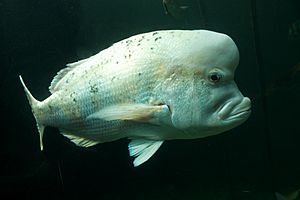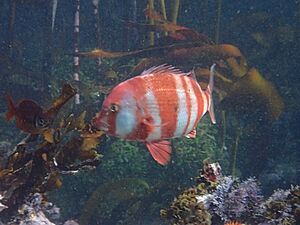Red stumpnose facts for kids
Quick facts for kids Red stumpnose |
|
|---|---|
 |
|
 |
|
| Old (above), young (below) | |
| Conservation status | |
| Scientific classification | |
| Synonyms | |
|
The red stumpnose, also known as the red stumpnose seabream or Miss Lucy, is a special type of fish. Its scientific name is Chrysoblephus gibbiceps. This fish lives in the ocean and is part of the seabream family, called Sparidae. You can only find the red stumpnose off the coast of South Africa, in the southwestern Indian Ocean. Sadly, experts say this fish is an Endangered species, meaning it's at risk of disappearing.
Contents
About the Red Stumpnose
Scientific Name and Discovery
The red stumpnose was first officially described in 1830. A French scientist named Achille Valenciennes gave it the name Chrysophrys gibbiceps. He found it near the Cape of Good Hope in South Africa.
Later, in 1839, another scientist named William Swainson placed this fish in a new group. He called this group Chrysoblephus. The red stumpnose became the main example for this new group.
What Its Name Means
The scientific name gibbiceps tells us something special about this fish. It comes from two words: gibbus, which means "hump", and ceps, which means "head".
This name refers to the big, rounded forehead that adult male red stumpnose fish have. It looks like a hump on their head.
How to Spot a Red Stumpnose
The red stumpnose has a body that is deep and flattened from side to side. Its body length is about 2 to 2.4 times its depth.
Its top fin, called the dorsal fin, has 11 or 12 strong spines and 10 or 11 soft rays. The fin underneath, called the anal fin, has 3 spines and 7 to 9 soft rays.
Special Features
The front of the fish's head slopes very steeply from its snout to its nostrils. As the fish grows older, a bump starts to form between its eyes. In very large adults, this bump becomes a big hump on the back of its neck. This makes its forehead stick out.
The fish's body is a reddish-orange color with shiny golden spots. Its belly is a bit lighter. It often has 5 to 7 faint red stripes going up and down its body. There are also many dark, uneven spots on its upper body.
The biggest red stumpnose ever recorded was about 75 centimeters (about 30 inches) long. However, most of them are around 50 centimeters (about 20 inches) long.
Where They Live
Habitat and Location
The red stumpnose lives in the ocean near the southern coast of South Africa. You can find them in the very southeastern Atlantic Ocean and the southwestern Indian Ocean. They are usually found between False Bay and East London.
Sometimes, they are seen as far north as Margate, South Africa. But these might be other similar fish that were mistaken for the red stumpnose.
This fish prefers coastal waters. They live at depths ranging from about 10 meters (33 feet) to 100 meters (330 feet).
Young vs. Adult Fish
Adult red stumpnose fish usually live on reefs far from the shore. Younger fish, however, gather in groups over rocky reefs in shallower water closer to the coast.
Red Stumpnose Life and Habits
Reproduction
Unlike some other fish in its family, the red stumpnose is not a hermaphrodite. This means each fish is either male or female, and they don't change sex.
They lay their eggs and reproduce from October to January. The busiest time for reproduction is in December, especially around the Agulhas Bank.
Male red stumpnose fish seem to be polygamous. This means one male might mate with several females. They may even compete with other males to get access to females.
What They Eat
The red stumpnose is a predator. It hunts and eats small creatures that live on the ocean floor. They have been seen eating crabs, snails, clams, and even small fish. However, their favorite food seems to be brittle stars, which are like starfish.
Behavior
Adult red stumpnose fish are territorial. This means they have their own areas that they protect. But when it's time to reproduce, they gather together. During this time, they move closer to the shore.
The red stumpnose can also have tiny parasites living on its skin. One example is a small worm-like creature called Anoplodiscus cirrusspiralis.
Fishing and Protecting the Red Stumpnose
A Popular Fish
The red stumpnose is known as a very tasty fish to eat. Because of this, it has been a target for both commercial fishing boats and people who fish for fun. They are often caught on the Agulhas Bank and in False Bay.
Conservation Efforts
To help protect the fish, rules have been put in place. These rules limit how many fish can be caught and how big they must be.
However, despite these rules, the number of red stumpnose fish has dropped a lot. Experts say that too much fishing has caused their population to crash. Because of this, the International Union for Conservation of Nature (IUCN) has listed the red stumpnose as an Endangered species. This means it needs special protection to survive.


